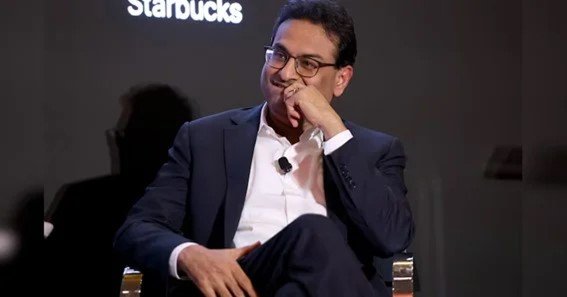Laxman Narasimhan, the Indian-born executive who took over as CEO of Starbucks in 2022, made headlines recently for his abrupt and unexpected departure from the company. This sudden change in leadership has left many in the business world speculating about what went wrong. Narasimhan, known for his successful tenure at Reckitt Benckiser, seemed like a strong choice to lead one of the world’s most iconic brands. However, just a year into his role at Starbucks, he was out—prompting questions about the factors that led to his downfall. In this article, we delve into the possible reasons behind his exit and what it means for Starbucks and its future.
The Promise and Potential of Narasimhan
When Laxman Narasimhan was appointed as CEO of Starbucks, there was a great deal of optimism surrounding his tenure. Narasimhan had an impressive track record, having revitalized Reckitt Benckiser, where he was credited with driving growth and implementing successful strategies. His leadership style, which balanced strategic vision with operational efficiency, was expected to bring fresh energy to Starbucks, particularly as the company navigated the post-pandemic landscape and increasing competition in the global coffee market.
The Misalignment of Leadership Style
However, it soon became apparent that Narasimhan’s leadership style might not have been the right fit for Starbucks’ unique culture. Starbucks is known for its customer-centric approach and a work environment that emphasizes collaboration, innovation, and a deep connection with both employees (referred to as “partners”) and customers. Some reports suggest that Narasimhan’s approach, which may have been more structured and top-down, didn’t resonate well within the company’s more fluid and inclusive culture.
Moreover, Starbucks has a history of being led by executives who are deeply ingrained in the company’s ethos, often rising through the ranks with a strong understanding of its values and operations. Laxman Narasimhan, coming from a different corporate background, might have struggled to adapt to this environment, leading to friction with other senior leaders and the board.
Strategic Disagreements
Another possible factor behind Laxman Narasimhan’s exit could be strategic disagreements with the Starbucks board. While specific details have not been made public, it’s possible that Narasimhan’s vision for the company’s future clashed with that of the board. This could include differences in opinion on how to tackle competition, expand in international markets, or innovate within the digital space.
Starbucks has been under pressure to maintain its market leadership amid rising competition from both established players and emerging brands, as well as the growing trend towards specialty coffee shops. The company has also been focusing heavily on digital transformation, with a strong emphasis on mobile ordering, loyalty programs, and delivery services. If Narasimhan’s approach to these critical areas didn’t align with the board’s expectations, it could have contributed to his removal.
Work Habits and Perception
Interestingly, some reports have highlighted Laxman Narasimhan’s work habits as a potential issue. It has been mentioned that he preferred not to work after 6 PM, a detail that has sparked considerable debate. In the high-stakes world of corporate leadership, where CEOs are often expected to be available at all hours, this perceived lack of availability might have been seen as a lack of commitment to the demanding role.
While work-life balance is becoming increasingly important, especially in the context of mental health and well-being, the traditional expectations of a CEO—particularly at a global powerhouse like Starbucks—may not have aligned with Narasimhan’s approach. This perception, whether fair or not, could have contributed to the decision to replace him.
Brian Niccol’s Appointment: A New Direction
The speed with which Starbucks replaced Narasimhan with Brian Niccol, the former CEO of Chipotle, suggests that the company was eager to bring in a leader with a proven track record of turning around a business and driving innovation. Niccol is credited with revitalizing Chipotle, focusing on digital growth, operational efficiency, and enhancing the customer experience—all areas that are crucial for Starbucks as well.
Niccol’s appointment indicates that Starbucks may be looking to refocus on operational excellence and innovation, potentially shifting away from any strategic direction that Laxman Narasimhan was pursuing. This move could signal a desire to bring the company back to its core strengths while adapting to the rapidly changing market dynamics.
The Impact on Starbucks and Its Future
Laxman Narasimhan’s abrupt exit raises important questions about the future of Starbucks. The company is at a critical juncture, facing challenges such as market saturation, increased competition, and evolving consumer preferences. The leadership change underscores the importance of cultural fit and strategic alignment at the highest levels of corporate leadership.
For Starbucks, the decision to replace Laxman Narasimhan with Niccol suggests a recommitment to a customer-first strategy, enhanced by digital innovation and operational rigor. Investors and stakeholders will be watching closely to see how Niccol steers the company in the coming years and whether he can deliver on the promise of sustainable growth.
Conclusion
Laxman Narasimhan’s departure from Starbucks after just one year as CEO is a reminder of the complex dynamics that can influence leadership at the top of a global corporation. While the exact reasons for his exit remain speculative, it’s clear that a combination of cultural misalignment, strategic disagreements, and possibly perceptions about his work ethic played a role. As Starbucks moves forward under new leadership, the company will need to navigate these challenges carefully to maintain its position as a leader in the global coffee market. Laxman Narasimhan’s experience serves as a cautionary tale about the importance of fit and alignment in the highest echelons of corporate leadership.
Disclaimer: This article is for informational purposes only and should not be taken as financial advice. Always consult a financial advisor for investment decisions.










